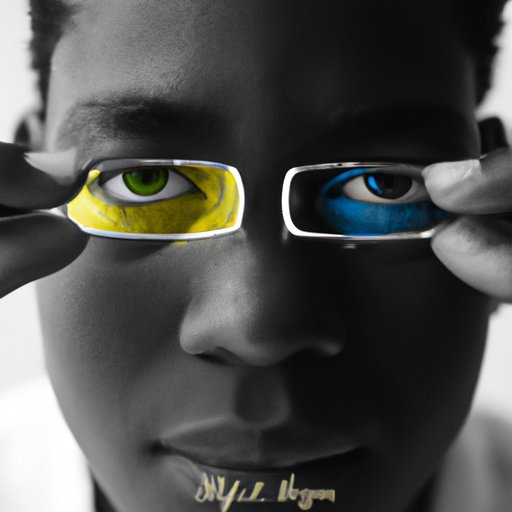Introduction
Color blindness, also known as color vision deficiency (CVD), is a condition that affects millions of people worldwide. This disorder prevents people from seeing colors in the same way as those without color blindness. People with this condition may have difficulty distinguishing between certain shades of color or even seeing any color at all. Although it can be difficult to live with, there are ways to cope with color blindness and still enjoy life.

Describing the Science Behind Color Blindness
The human eye contains special cells called cones which are responsible for perceiving color. These cells contain pigments that are sensitive to different wavelengths of light. In people with color blindness, either one or more of these pigments are missing or not working properly. As a result, they may have difficulty distinguishing between certain colors or even seeing any color at all.
Color blindness is usually detected through a series of tests. An optometrist or ophthalmologist will first check your visual acuity to make sure it is within normal range. They may then use an Ishihara test, which is a series of plates containing colored dots in various patterns. The patient is asked to identify what the pattern is, and if they cannot see the pattern, then it is likely that they are color blind.

Explaining the Types and Causes of Color Blindness
There are three main types of color blindness: monochromacy, protanopia, and deuteranopia. Monochromacy is the most severe form of color blindness, where the person is unable to distinguish any colors. Protanopia and deuteranopia are both forms of red-green color blindness, where the person has difficulty distinguishing between these two colors.
The exact cause of color blindness is unknown, but it is believed to be genetic. Other possible causes include injury or disease that affect the eyes, certain medications, or exposure to certain chemicals. It is also more common in men than women.
Examining the Impact of Color Blindness on Everyday Life
Living with color blindness can present many challenges in everyday life. For example, in school, color coded materials such as maps and diagrams can be difficult to interpret. In the workplace, tasks that require color recognition, such as sorting colored wires or reading colored labels, can be difficult or even impossible. Additionally, color blindness can lead to social implications, such as feeling left out or misunderstood when others talk about colors.
Investigating Current Treatments for Color Blindness
Fortunately, there are several treatments available for color blindness. Glasses and contact lenses are available that can help correct some of the deficiencies in color perception. Color correction software can also help to enhance the appearance of certain colors on a computer or mobile device. Other treatments include dietary supplements, specialty lenses, and vision therapy.
Analyzing How Technology is Helping Those with Color Blindness
Technology is playing an increasingly important role in helping those with color blindness. There are a number of apps and tools available that can help identify colors, such as Colorblind Assistant and Color ID. Wearable devices, such as EnChroma glasses, can also help to improve color perception. Additionally, there are a growing number of accessible platforms and websites designed specifically for those with color blindness.

Showcasing the Stories of People Living with Color Blindness
It can be inspiring to hear the stories of people who are living with color blindness. Many of them share their personal experiences, coping strategies, and inspirational messages to encourage others. For example, Matthew Might, a professor at the University of Utah, wrote a blog post about his experience with color blindness and how he has learned to cope with it. His story is just one of many that demonstrate the resilience of people living with color blindness.
Conclusion
Color blindness is a condition that affects millions of people worldwide. It can present challenges in everyday life, but there are treatments available that can help improve color perception. Technology is also playing an important role in helping those with color blindness, and it is encouraging to hear the stories of people living with the condition. Further research into color blindness is necessary to better understand the condition and develop more effective treatments.
(Note: Is this article not meeting your expectations? Do you have knowledge or insights to share? Unlock new opportunities and expand your reach by joining our authors team. Click Registration to join us and share your expertise with our readers.)
